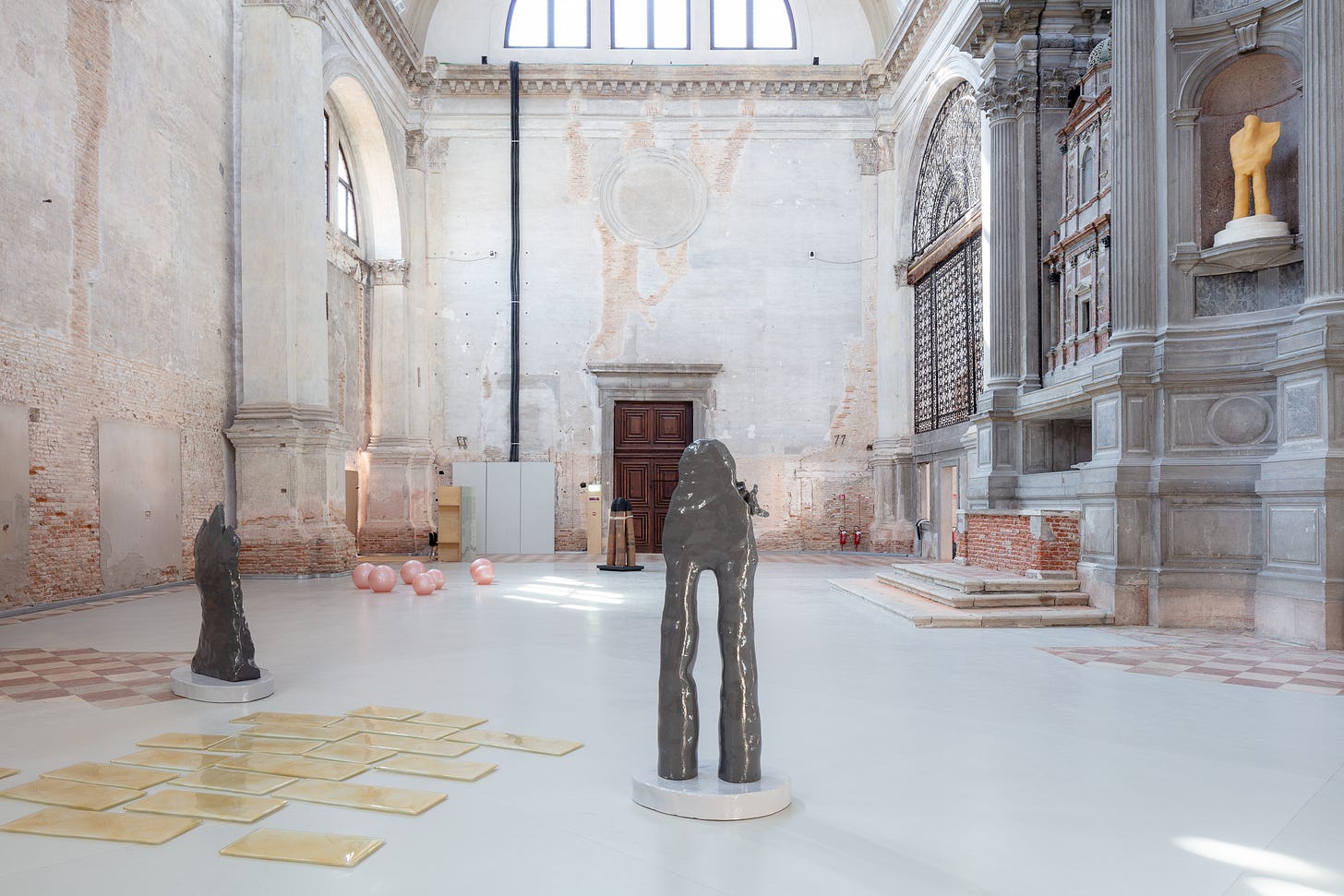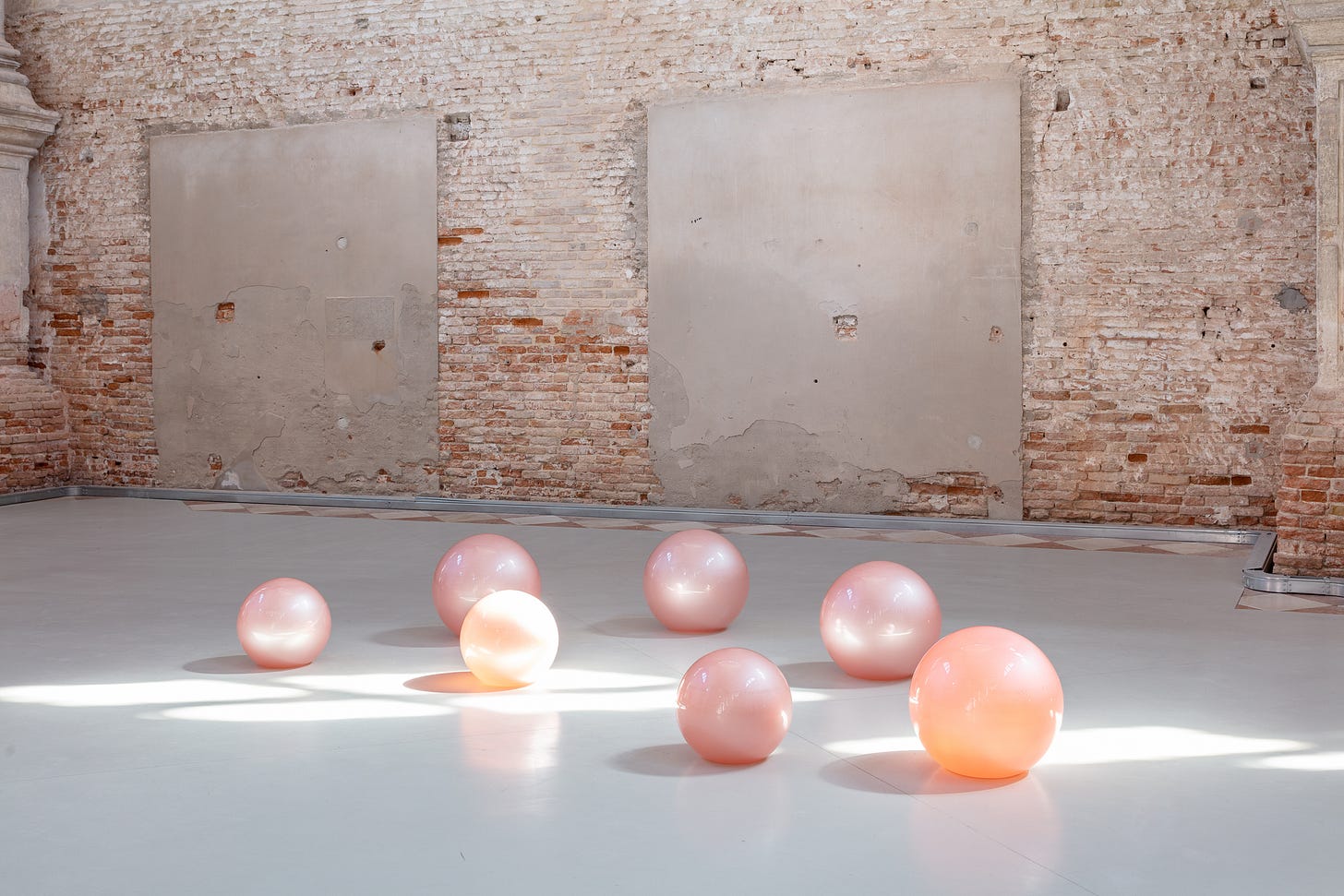Furry Concerts and Bubblegum Poetry
What do a catcalling sailor, a Spanish lullaby, and two artists dressed up as seagulls have in common? "Thus Waves Come In Pairs" stirs a boiling ocean.
Thirsty for Art and Knowledge
With the Mediterranean Sea’s climate changing at a rate 20% faster than the world's oceans, it’s about damn time that Venice is getting some UNESCO protection with the future prospect of turning into a real-life Atlantis. Ocean Space inside the former convent of San Lorenzo is dedicated to learning from bodies of water through art exhibitions.
Inspired by the poetry of late Lebanese-American artist Etel Adnan (1925-2021), the show “Thus Waves Come in Pairs” brings together the works of French-Lebanese sculptor Simone Fattal (Babyboomer) and the Berlin-based Millenial collaborators Petrit Halilaj (Bosnian) & Álvaro Urbano (Spanish).

Gentlemen, it has been an honor.
Petrit & Álvaro turned the west wing of the church into an underwater concert hall, the Lunar Ensemble for Uprising Seas. Silvery poles and sticks carry flat aluminum shapes of sea creatures. Each figure is one of 40 musical instruments: A fish-like flute sounds like a whale, another fish played like a drum sounds like waves hitting cliffs at the shore. A stingray plays the lullaby ¡Ay mi pescadito! that Álvaro often heard as a child. It’s a song about a helpless fish becoming a mighty whale one day. Is the music a roaring call to war for the endangered ocean or are we passengers on the Titanic being lulled into sleep one last time? Maybe the egg-shaped moon that controls the tides is the conductor of this orchestra?

But the seagulls don’t run this city, we do.
What rats are to New York, seagulls are to Venice. And we might be to nature what seagulls are to us: Annoying parasites. On five occasions, Petrit and Álvaro orchestrate a live concert dressed up as the seagulls Sali & Tabacchi, referring to the signage of countless Italian Tabacco stores. In these concerts, performers play the instruments in a celebrating parade walking from the square into the church. The moon that once controlled the sea is now replaced by humans who claimed power over the ebbs and flows of oceans in a matter of decades. A celebration of power over nature might soon become a funeral with Mother Nature dancing on our graves.

A Mediterranean roadtrip
Simone maps out the Mediterranean Sea through stories and sculptures in the east wing of the church: A briccola as used to navigate the Venetian Lagoon leads to pink pearly bubbles made of Venetian Murano glass. Hardly visible text carved into every single pearl recites fragments of a poem in Lingua Franca, an ancient language of the Mediterranean. The 14th-century text sets the scene off the Tunisian coast: a distressed mother confronts a sailor for seducing her daughter, while the sailor, to put it in simple terms, tells her to mind her business.

The pearls effortlessly connect to the love story of Máyya and Ghaylán, a couple whose story is set on the coast of modern-day Qatar. Their abstract earthenware figures are tied together through a golden sea laid out in glass tiles. The lovers are pearl searchers competing against each other. One day, a dragonfly rests on Ghaylán’s shoulder, inspiring him to invent sails and therefore making his fleet faster than his lover’s. The glazed sculptures and objects reflect the light projected from across the room and coming in from the windows outside, bringing us to the Greek temple figures in the niches above the altar.

The mirror object ΓΝΩΘΙ ΣΑΥΤΟΝ bears the Greek words “gnōthi seautón”, know thyself, picking up the literal reflection of light and turning it into an inward, personal reflection. The niche on the other side of the altar contains “Young Boy” a matt ochre figure that really looks like the opposite of knowing oneself: Anonymous, abstract, faceless. The connection of Greek mythology to water seems a bit off though. Especially given that the motto know thyself was reserved for the temples of Apollo, the God of sun and poetry, and not Poseidon, I feel like this is a missed opportunity. Are we just keeping it on the level of inward reflection and the soul like a deep ocean?
A slippery concept?
When I first saw the exhibition, I felt like the curator doesn’t do justice to the artists by joining work worth two separate exhibitions into one. But then I started thinking about the title “Thus Waves Come in Pairs”, and I realized: It is necessary to have both in one space. The exhibition is like the two sides of water. Petrit and Álvaro show us the depth of the ocean and Simone tells stories of the surface we inhabit as humans. One is about the human relationship to water and the other is about the relationships within water. Two different POVs, if you will, that come in pairs.
Read some poetry and play ocean music at Thus Waves Come In Pairs at Ocean Space until November 5, 2023.
Ocean Space
Chiesa di San Lorenzo, Castello 5069
30122 Venezia VE, Italy
Open from Wednesday until Sunday from 10 am to 6 pm
Free entry
https://www.ocean-space.org/
I hope that after this review, seagulls make you think of art. Stay up to date by subscribing to this substack and send this review to a friend. Sharing is caring :)
See you soon!
Jennifer
The Gen Z Art Critic





